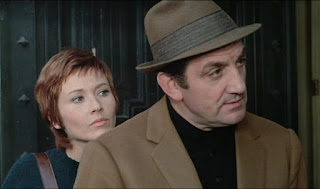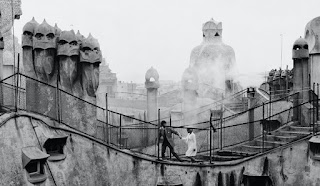July has come to a close and I watched a fair amount of new-to-me movies. I know of a couple of themes or challenges people tackled in July but after Junesploitation — I wanted to follow my own yen when choosing films to watch. The result was a fair amount of crime flicks, lots of French films, and a smattering of horror. I had a few notable re-watches including The Beyond which was part of the Cinema of the Macabre screenings last month. I’m not going to write more about The Unknown Man of Shandigor or Last Known Address here but you can look at my reviews of both as they were certainly among my favorite things I watched in July.
Alphaville (1965) — I think this is actually a re-watch but it’s been so long that it felt new. I’ve had a copy sitting on my shelves for ages and had not found the right moment to put it on. Samm Deighan lists several movies in her commentary for Shandigor to help contextualize that film and Alphaville alongside Dr. Strangelove seems like a critical touchpoint. Alphaville strikes me a far less satirical but a nonetheless fascinating and entertaining distillation of film noir through an arthouse/sci-fi lens. This would be such a treat theatrically.
Tough Guys Don’t Dance (1987) — A film that is notorious for its mind bendingly over the top dialogue and one that I’m finally seeing in total thanks to the Vinegar Syndrome blu-ray release. It’s hard to discern what is parody or just drug-fueled wildness but the outsized noir stylings should not be missed. Each line delivery is a revelation and each narrative turn is a “holy shit!” moment.
Maigret Sets a Trap (1958) — I watched the first two of the three Maigret films featuring Jean Gabin as the Parisian inspector. Definitely worth checking out if you are a mystery fan — they’re both engrossing, well composed narratives and Jean Gabin is his usual charismatic presence. Gabin manages to be both affable and believably tough in his interpretation of Maigret and I enjoy his everyday interactions with people almost as much as I appreciate the crime solving. Lots of fun actors turn up in these but Maigret Sets a Trap features a blink-and-you’ll-miss-it appearance from Shandigor’s Daniel Emilfork.
A Pain in the Ass (1973) — This was a blind buy for me after hearing it referenced in the Projection Booth episode covering the Billy Wilder remake with Jack Lemmon and Walter Matthau. Though I love Lino Ventura I haven’t seen many of his comedic performances and Pain in the Ass is from the same writing/directing team who made La Cage Aux Folles so this seemed like a good place to start. I had a blast watching this! Jacques Brel plays the perfectly neurotic foil to Ventura’s increasingly frustrated hitman. If your idea of a black comedy includes some bloodshed and Lino Ventura hilariously moving from irritation to red-faced fury then this is well worth checking out.
Max and the Junkmen (1971) — I wrote earlier this month about how Last Known Address turns the frustrated cop narrative on its ear by having the protagonists lean into solid, by-the-books detective work rather than going rogue. In Max and the Junkmen the independently wealthy judge turned renegade cop goes full blown class warfare on a group of petty scrap thieves by manipulating them into attempting a bank heist only to bust them. It’s an absolutely wild story compellingly brought to life through Claude Sautet’s direction and excellent performances from some of my favorites — Michel Piccoli, Romy Schneider, Bernard Fresson, and Boby Lapointe. Must watch for French crime enthusiasts.
Homebodies (1974) — I might actually do a full-length review of this one so I’ll be brief here, but Homebodies is a delightfully weird slice of regional genre filmmaking that delves into some novel territory. It’s the story of a group of elderly apartment dwellers who don’t want to move after their tenement building has been purchased by a developer. Progress on the development is delayed after the accidental death of a construction worker they band together to engineer further “discouragements.” This gets labeled as horror and has a review in Nightmare USA but might fit more in the broader exploitation category. Well worth your time if you like regional strangeness.
The Diabolical Dr. Z (1966) — Another follow up watch from Shandigor for me. This is Jess Franco’s pulpy take on Eyes Without a Face and I found it absolutely captivating. Gorgeous black & white photography, bizzarro mad scientist set pieces, murderous fingernails, and of course some glorious zooms. I’ll probably have to add a copy to my growing Franco collection.
The Wages of Fear (1953) — One of my mantras — lifted from Edgar Wright — is that it’s never too late to see a great movie. I think the length of Wages always kind of put me off watching it but the mood was right so I finally put in on. Astonishing. It takes its time to get moving but then it is white knuckle tension through and through. The stunning film craft is the primary reason to watch but the ferocious critique of capitalism, colonialism, and energy policy are sadly just as resonant today.
Two Men in Town (1973) — José Giovanni’s brutal indictment of the French criminal justice system and the death penalty. It’s a good drama further buoyed by terrific performances from both Jean Gabin and Alain Delon. As I mentioned in my Last Known Address review — it’s hard to give Giovanni’s societal critique much credulity when you understand the nature of his criminal past. However, I read a tremendous article regarding Giovanni by author Imogen Sara Smith and to quote that — “In every heart there are undiscoverable gardens.” If you can hold Giovanni’s filmmaking at arm’s length from his biography — there’s a lot to appreciate here. Also, did you know that France used the guillotine as the only available means of execution until the death penalty was abolished in 1981? I did not.
The Man from Hong Kong (1975) — Man from Hong Kong is one of those films I’ve been holding off on watching until the right opportunity presented itself and what better possible venue could I have hoped for than seeing one of the only 35mm prints in existence at the Trylon? A staggering, swaggering blend of Golden Harvest martial arts mayhem and Brian Trenchard Smith’s stunt action. In fairness — Jimmy Wang Yu isn’t my favorite kung-fu performer but there’s a grittiness to his style and his legendary off-screen ferocity seems to translate on-screen as well. I think the real pleasure here is the stunt sequences — cars smashing & crashing, explosions, free falls, lots of hang gliding, and George fucking Lazenby on fucking fire. Sheer madness. It was also a real pleasure to see so much of the cast of Stone — particularly Hugh Keays-Byrne who inexplicably plays the straight laced cop despite maintaining much of his biker look. There is some racist garbage featured here that wasn’t welcome but Man from Hong Kong is still primarily about Jimmy Wang Yu storming the hell out of Australia and — maybe I’m reaching here — brought to mind some of the anti-imperialist themes from Tsui Hark’s Dangerous Encounters of the First Kind. Politics aside — this was an absolute delight to see projected and as a bonus I got to hang out with some folks from the Cult Film Collective who have been instrumental in some of my favorite local screenings.
Arcana (1972) — Though I have seen and enjoyed Giulio Questi’s oddball giallo Death Laid an Egg — Arcana wasn’t really on my radar until it was recently covered in an episode of the Unsung Horrors podcast. Lance and Erica prepared me for a film that wouldn’t deliver a lot of narrative clarity and could be potentially frustrating but they were drawing in so many other great film references I had to check it out. I loved it. Despite the crappy transfer I watched on YouTube — I thought Arcana was strange and captivating and definitely thought provoking. I watched the ending twice and then went and re-listened to parts of the podcast and I still don’t quite know what to make of it. There’s a scene that’s some kind of ritual or exorcism underscored by this hypnotic droning violin music that is so much my kind of deal — and that’s even before Lucía Bosé legitimately starts spitting up live frogs. I would LOVE to see a restored version of this. How about a second volume of the Severin folk horror box?
That pretty much does it for my favorite new-to-me watches. As always — I’d love to hear your thoughts on these or further recommendations if you’ve got any!























